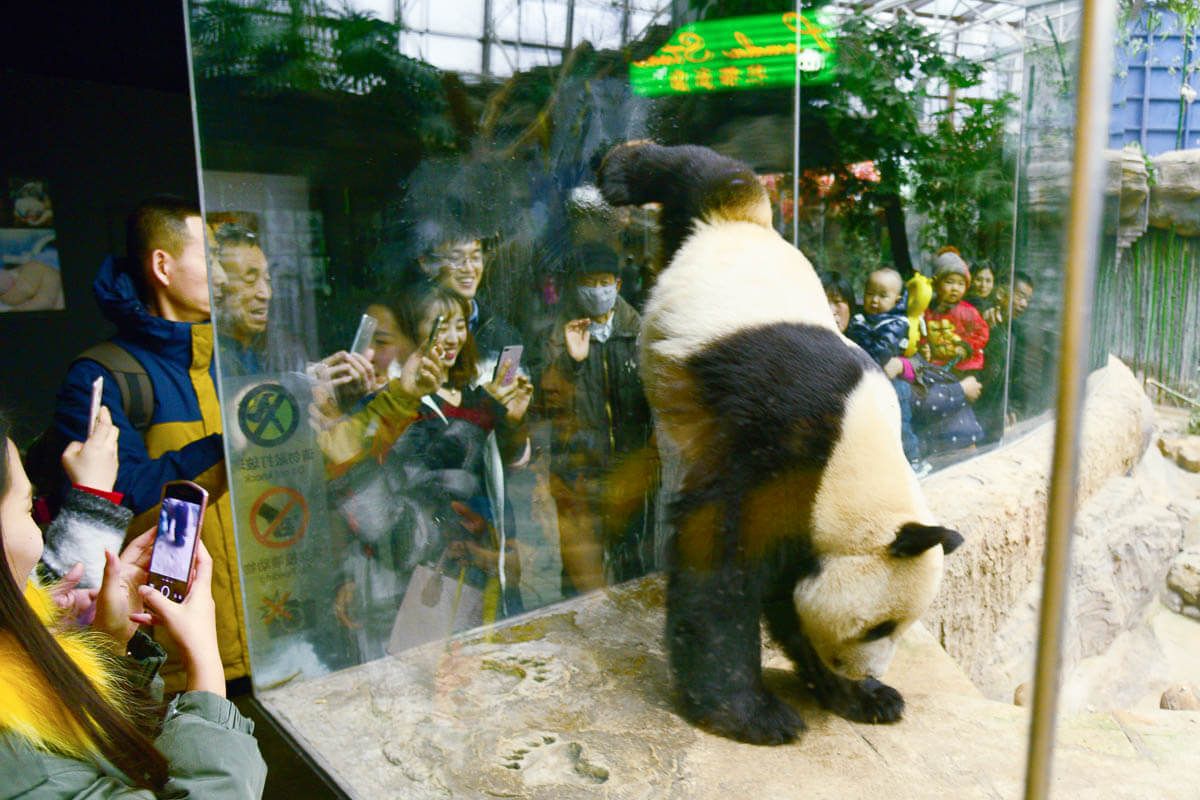

The world is wide and wonderful — and pretty weird. Take a break from your day and prepare to smile over this assortment of random facts, from the pseudo-medical roots of tomato ketchup to Antarctic matchmaking. What was Uranus called before Uranus? Why do giant pandas do handstands? These 15 facts may just give you a chuckle.
A Butt Is a Unit of Measurement

If we’re talking imperial measurements, a “butt” is a cask of liquid. And while this form of “butt” is obsolete for most people, it’s still used in wine and brewing contexts. In the wine world, a butt is around 108 imperial gallons (just under 500 liters, or around 126 U.S. gallons), so it turns out that a buttload is… a buttload.
Uranus Used to Be Called “George’s Star”

Despite the fact that Uranus is four times the size of Earth, it took astronomers a while to realize it was a planet rather than a star, even after telescopes came along. English astronomer William Herschel made the first recorded discovery of Uranus as a planet in 1781, during the reign of King George III. He named the planet Georgium Sidus, or George’s Star, in honor of the king. The international astronomy community was less than thrilled about a planet being named after an unpopular British monarch rather than a deity, and in 1850 settled on naming the planet Uranus, after the Greek god of the sky.
Ketchup Used to Be Sold as Medicine

A lot of dangerous things were sold as “patent medicine” in unregulated 1800s America, including mercury, lead, and arsenic. Meanwhile, tomatoes, which are in the same family as deadly nightshade, were considered unsafe by much of the population until they were sold as a cure-all. Dr. John Cook Bennett was one of the tomato’s biggest boosters, and claimed the fruit would protect migrants heading west “from the danger attendant upon those violent bilious attacks to which all unacclimated citizens are liable.” He provided several tomato recipes to be taken as medicine, including catsup, which, at the time, typically contained mushrooms and/or walnuts.
Eventually, Americans figured out that tomato ketchup worked much better as a tasty condiment than medicine — but to be fair to Dr. Bennett, he did suggest using it as a replacement for mercury, so he may have helped some folks out.
The Dating App Tinder Works in Antarctica

Antarctica is the most sparsely populated continent on the Earth, with only about 1,000 people over the winter (none of them permanent residents) in more than 5 million square miles. So when an American scientist opened the Tinder app at a research station in 2014, it was mostly out of curiosity. To his surprise, he matched with another researcher camping a 45-minute helicopter ride away. They didn’t meet until a few weeks after swiping right, just as his match was leaving town, but considering the population only grows to about 5,000 people in the summer, the chances that their paths crossed again seems high.
A Jiffy Is a Real Unit of Time

For a term that seems so cutesy, the literal use of “jiffy” is extremely scientific. Physicists use the term to describe how long it takes for light to travel a millionth of a millionth of a millimeter, which is less than a billion-billionth of a second. A jiffy is a little longer in electrical contexts; it’s the length of a single cycle of alternating current, or about one-fiftieth of a second. So next time you say you’ll be “back in a jiffy,” consider what you’re promising!
Giant Pandas Sometimes Do Headstands to Pee

No, it’s not a human-taught trick: Wild giant pandas have been known to do handstands while relieving themselves, especially during mating season. Because, unfortunately, there aren’t too many giant pandas around — and they don’t have a ton of energy to spare — they want to broadcast their scent as widely and efficiently as possible to potential mates. This means finding trees with rough bark for greater absorption, choosing wide trees to increase the target area, and aiming as high as possible. The handstand gives male pandas a much-needed leg up (literally).
The Blob in Toothpaste Ads Is Called a “Nurdle”

A toothbrush with a picturesque swirl of toothpaste, called a “nurdle” in the industry, is a mainstay of advertisements, and became especially popular as brands started releasing more colorful products in the 1970s. It’s a goofy factoid for most of us, but toothpaste manufacturers take nurdles very, very seriously.
In 2010, GlaxoSmithCline, the maker of Aquafresh, applied to trademark the nurdle design in any color. Colgate-Palmolive, which also used a nurdle to advertise its products, took it as a legal threat — the company’s lawyer called it “a blatant shot across Colgate’s bow” — and sued to protect their imagery and get the trademark petition canceled. GlaxoSmithCline countersued, alleging that Colgate’s nurdle caused “irreparable harm.”
The two companies eventually came to a confidential settlement, but still: Who knew the toothpaste industry was so wacky… and so litigious?
Humans Could Frame Koalas for a Crime (or Vice Versa)

Strangely enough, koala fingerprints strongly resemble those of humans — the pattern of ridges and whorls looks even more similar to our own than chimpanzee fingerprints. Though distant on the evolutionary tree from us primates, koalas likely developed fingerprints to help them grasp eucalyptus trees while climbing them and munching on their leaves. In the ’90s, a forensic scientist at the University of Adelaide in Australia warned that koala prints are so similar to human prints, it’s possible police in Australia could mistake one for another. “Although it is extremely unlikely that koala prints would be found at the scene of a crime, police should at least be aware of the possibility,” Maciej Henneberg noted.
Sea Lions Can Keep a Beat

Most humans can at least tap their toes to the beat of some music, but aside from a few primates, the majority of mammals can’t — or at least haven’t shown us that they can. Sea lions are an exception. In 2013, a pair of scientists taught a “particularly bright sea lion” named Ronan to bob her head to simple rhythmic sounds. It took her a few months to master those, but once she had those rhythms down, she could keep the beat to songs she hadn’t heard before, including “Everybody” by the Backstreet Boys (a nod to a previous case of a parrot keeping a beat) and “Boogie Wonderland” by Earth, Wind & Fire, even when the songs were adjusted to various tempos.
A Welsh Town Has a Tourist-Drawing 58-Letter Name

Next time you’re in Wales, you might have the opportunity to visit Llanfairpwllgwyngyllgogerychwyrndrobwllllantysiliogogogoch — or, as it’s often simplified on maps, Llanfair PG — a fishing village on the Isle of Anglesey in the northern part of the country. The name translates to “the church of Mary in the hollow of the white hazel near the fierce whirlpool and the Church of Tysilio by the red cave,” and it replaced the town’s shorter name, Llanfair Pwllgwyngyll, in the 1860s in hopes of drumming up tourism from a new railroad line. It worked, and visitors still pop through for souvenirs and passport stamps.
Bear in mind that in the Welsh alphabet, many pairs of letters function more like single ones, so while it’s still comically long in Welsh, to English speakers it’s even more dizzying. The place name is sometimes referred to as “the Englishman’s Cure for Lockjaw.” It still stops short of being the longest place name in the world, though; Bangkok’s full name is Krung Thep Mahanakhon Amon Rattanakosin Mahinthara Ayuthaya Mahadilok Phop Noppharat Ratchathani Burirom Udomratchaniwet Mahasathan Amon Piman Awatan Sathit Sakkathattiya Witsanukam Prasit.
People Used to Mail Their Children Via the Postal Service

When the United States Postal Service launched their parcel service in 1913, Americans immediately began testing its boundaries. People started mailing coffins, eggs, and even dogs, and a few decided to mail the ultimate precious cargo: human children.
The first known case of baby-shipping happened that same year, when an Ohio couple mailed their 10-pound infant to his grandmother a mile away, which cost them about 15 cents. Some kids traveled farther, like 6-year-old Edna Neff, who was mailed 720 miles from Pensacola, Florida, to her father’s home in Christiansburg, Virginia.
There was only a brief window for mailing kids, though; the postmaster general instituted a strict no-humans rule in 1914. At least two more children managed to slip through: Charlotte May Pierstorff was mailed via rail to her grandparents’ house with the appropriate postage stuck to her coat in 1914, but a postal worker relative escorted her (her story was later turned into a children’s book). The last recorded case was in 1915, when 3-year-old Maud Smith’s grandparents mailed her 40 miles across Kentucky to visit her sick mother. In 1920, the Postal Service declined two applications to mail children who had been listed as “harmless live animals,” a classification for creatures that don’t require food or water on their journey.
Eating Too Many Carrots Can Turn You Orange

Carrots and other similarly colored vegetables like yams get their color from a pigment called beta carotene, which converts to vitamin A in the small intestine. When humans eat too much beta carotene, our small intestines can’t process it all, and the excess pigment hits our bloodstreams instead. If someone eats enough carrots to overload their body with beta carotene consistently over a long period of time, their skin can start to look a little orange, particularly on the palms of the hands, soles of the feet, and nose. This syndrome is called carotenemia, and it usually only affects babies and toddlers who chow down on a little too much puree. It’s weird, but it’s generally harmless.
The Earliest Recorded Joke Was a Fart Joke

It’s impossible to know what the first joke in history was, but we have a few ancient written examples. The oldest known written joke, circa 1900 BCE, came from ancient Sumeria, in what’s now southern Iraq.
This is the joke: “Something which has never occurred since time immemorial; a young woman did not fart in her husband’s lap.” It doesn’t really translate to today’s humor — like many jokes, maybe you just had to be there.
German Chocolate Cake Was Invented in Texas

German chocolate cake, which alternates layers of buttermilk-and-chocolate cake with a pecan and coconut topping, sounds like it must come from Germany — but neither coconut nor pecans are part of traditional German cuisine. The recipe actually originated in Dallas, Texas, and the “German” part refers to a person named Samuel German, an employee of Baker’s Chocolate. The product Baker’s German’s Sweet Chocolate was his own formula of presweetened chocolate, and the recipe, which first appeared in the Dallas Morning News in 1957, used it as a main ingredient.
Norway Knighted a Scottish Penguin

When the Norwegian King’s Guard visited Edinburgh, Scotland, for a drill display in 1961, Major Nils Egelien paid a visit to the Edinburgh Zoo, and became absolutely enamored with the king penguins that reside there. (Apparently, the march of the king penguins reminded him of the march of his own King’s Guard.) When he returned to Scotland in 1972, he insisted that his regiment adopt a penguin — although the penguin stayed at the zoo — as their mascot. The penguin, named Nils Olav after both his No. 1 fan and the king of Norway at the time (King Olav V), eventually climbed the Norwegian military ranks. He was made corporal in 1982, and was officially knighted in 2008. As of 2023, his official title in the Norwegian King’s Guard is Major General Sir Nils Olav III, Baron of the Bouvet Islands. Major general is the third-highest rank in the Norwegian Army — and he officially outranks the original (human) Nils.
Before you Google “how long do king penguins live”: They’re on the third penguin.
